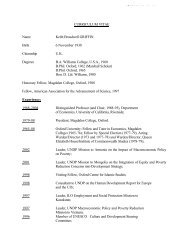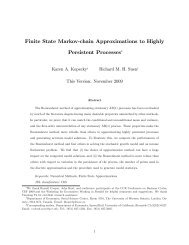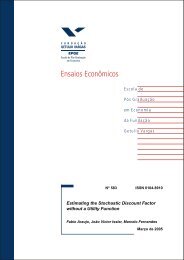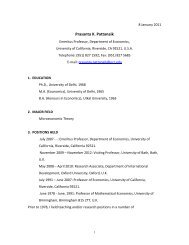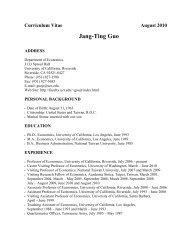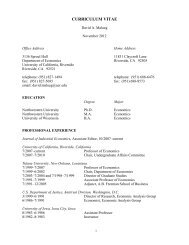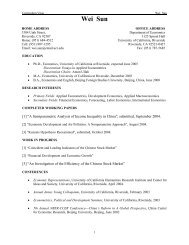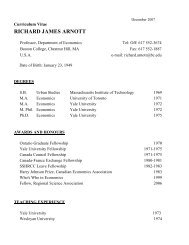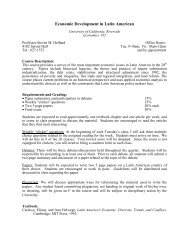Copula-based Multivariate GARCH Model with ... - Economics
Copula-based Multivariate GARCH Model with ... - Economics
Copula-based Multivariate GARCH Model with ... - Economics
You also want an ePaper? Increase the reach of your titles
YUMPU automatically turns print PDFs into web optimized ePapers that Google loves.
is then captured by a copula. To our knowledge, no previous models incorporate correlation and<br />
dependence at the same time. Instead, they focus only on the dependence by modeling shape parameter<br />
in copula, Kendall’s τ, or Spearman’s . Different from the existing financial applications<br />
of copula theory, which focus on (conditional) dependence and ignore the (conditional) correlation,<br />
our C-M<strong>GARCH</strong> models aim to model both dependence and correlation. ¤<br />
Remark 5: The variance-covariance approach to optimal portfolio allocation is rooted on the<br />
assumption of multivariate normality or ellipticality. Without multivariate normality or ellipticality,<br />
the variance-covariance approach may not be valid in that we do not consider the higher moments of<br />
the joint (non-normal) distribution of the assets for portfolio allocation. The appropriate approach<br />
to portfolio allocation under non-normality has been an active research area. For example, Harvey<br />
and Siddique (2000), Patton (2004), Krause and Litzenberger (1976), Singleton and Wingender<br />
(1986), among others, attempted to incorporate the higher moments (conditional skewness and<br />
conditional kurtosis) in asset pricing and portfolio analysis.<br />
In this framework, modelling the<br />
conditional higher moments (or cumulants) may also be computed from the generalization of the<br />
Hoeffding’s formula. Heoffding’s lemma (Hoeffding 1940) gives an integral representation of the<br />
covariance of two or more random variables in terms of the difference between their joint and<br />
marginal probability functions. The cumulant generalization of the Hoeffding’s formula gives an<br />
integral representation of the cumulants of two or more random variables (Block and Fang 1988,<br />
Theorem 1). While we only focus on the conditional second moment (M<strong>GARCH</strong>) in this paper,<br />
generalization to the conditional higher moments may be possible using the cumulant generalization<br />
of the Hoeffding’s formula. Hence, our C-M<strong>GARCH</strong> model is a simple case that can certainly be<br />
generalized to the conditional higher moments of the multivariate non-normal distributions. ¤<br />
Remark 6: Given the marginal distributions and the copula, one can always work out the<br />
implied correlation. In fact, Patton (2006, Footnote 19 and Figure 2) calculated the implied conditional<br />
correlations. Our paper is motivated to compute directly the conditional correlation and<br />
dependence, simultaneously and separately.<br />
What makes our paper different from some of the<br />
papers in the M<strong>GARCH</strong> literature using non-normal multivariate density is that our paper takes<br />
advantage of existing M<strong>GARCH</strong> models and of copulas. By doing this we model the conditional<br />
correlation (by M<strong>GARCH</strong>) directly and at the same time the conditional dependence (by copula)<br />
as well. 5 ¤<br />
5 The semiparametric copula-<strong>based</strong> multivariate dynamic (SCOMDY) model of Chen and Fan (2006) is different<br />
from our C-M<strong>GARCH</strong> model. The SCOMDY model is a multivariate model (like ours) to model the non-normal<br />
distribution using the copula function for the standardized process by using univariate conditional variance, the<br />
diagonal elements of H t . However, the SCOMDY model does not model the conditional co-variance, the off-diagonal<br />
9




